Jade Cocoon
Here's an exhaustingly long post about a hugely influential game from my childhood that I recently replayed!
Have I ever written about this game before? I must have at least mentioned it. It played a huge role in my childhood - maybe like MARDEK did for people who grew up with that - and influenced a lot of my own creative work.
(Knowing how poor my post-brain-surgery, isolation-ravaged memory is, I might very well have written a long post about it years ago, but if I did, I don’t remember it at all!)

I’m ostensibly an indie games developer, and there are so many modern indie games out there that I should play… but instead I devoted my time to replaying this old thing for the umpteenth time!
I started replaying it during the downtime I talked about in my previous post, via the RetroArch emulator on my phone. It didn’t take long; my final play time was about 13 hours, and that was with trying to find and experience everything the game had to offer.
The game was released for the original Playstation in 1999, so I must have been around 11 or 12 when I first played it? I remember discovering it on a free demo disk, then seeing a single copy of the full version in a shop and begging my mum to buy it for me or something, though my memories are hazy.
It’s a kind of monster-catcher, which I - still very much drunk on Pokemon fever at the time - was hungry for and eagerly gobbled up (mixed metaphors!). I replayed it many times, as I often did with games back then (I really miss experiencing games that way).
There are many things that I never noticed or appreciated back then, but did this time around now that I’ve spent years developing my own games.
Unlike Pokemon, the story and setting have a serious, contemplative feel to them, with spiritual, religious, tribal aesthetics and themes that I appreciate even more now than I did as a child. The intro - which I found on YouTube to include here; a Studio Ghibli designer worked on the game, and it shows - mentions stuff like how the game world’s god, Elrihm, created ‘divine spirits’, who in turn created ‘beasts of knowledge’ (humans) in their image. Reminiscent of the Nephilim from the Bible, one of the ‘divine spirits’ had a bit of incestuous loinsy fun with their creation, which introduced evil into the world… or something.
None of which I understood as a child!
You play as a young man who’s essentially forced into becoming a ‘cocoon master’ - one who traps and trains ‘minions’ - to save your village after it’s attacked by ‘locusts of the Apocalypse’. His childhood friend is forced to become his wife - because she’s a ‘Nagi’, and it’s tradition that cocoon masters have a Nagi wife - and after capturing minions, she has to ‘purify’ them for him, which destroys her body in the process as she absorbs their dark energy into herself.
So yes, I suppose it’s more mature than Pokemon in many ways!

I’ve been thinking a lot over the past few years about how to structure the stories/gameplay progression of my games (eg Atonal Dreams, Dreamons), so I was paying particular attention to that.
In Jade Cocoon, there’s a loooong series of scene-setting cutscenes etc before you can actually capture your first minion, which I wasn’t overly fond of. There are a couple of battles among them - taking place in the protagonist’s dreams - but they’re unwinnable, which I suppose fits with themes of powerlessness to resist duty, and gives you a place of clear weakness to grow from.
You then have a hub area - your village, Syrus - which you navigate using a menu rather than running around on foot… but you only really have to go to a couple of places. All the others are optional, homes of NPCs and such. All of the NPCs have names, portraits, and unique models though, no ‘Commoner’, ‘Man’, etc.
Perhaps most surprising to me during this playthrough was that a lot of these NPCs - despite being entirely optional and with zero plot relevance - have a LOT of dialogue, probably all of which I completely missed as a child. They say several text boxes worth of stuff, then if you talk to them again they say MORE text boxes of stuff. Then if you talk to them again they have MORE to say, and sometimes that keeps on going up to like six times!
And when the plot state changes, the NPCs also have several new pages of different dialogue, and many move to different places.
Typically games would use one bit of dialogue and maybe a second which the NPC would alternate between, so this really goes overboard comparatively! Seems to me like a lot of effort for something that’d probably be either accidentally or deliberately missed by almost all players…
And a lot of the dialogue is voiced, too! Not so much for the NPCs, but major characters often have these three or four several-page optional dialogue bits that are fully voiced. Surprisingly competently, too, considering when the game was made. The dialogue in general seems relatively well-written, too; better than some modern games I’ve played (a Star Ocean 2 remake thing comes to mind).
I can’t say the story as a whole makes all that much sense, though I’ve been noticing that increasingly often about stories in general as I get older and more discerning/bitter. I wonder how much of it was cut due to development time constraints, though.
The strange structure makes me suspect as much. After all the intro stuff, you have to venture out of Syrus and into ‘the forest’, which has four entrances to monster/minion-filled dungeons.
At first you can only enter the ‘Beetle Forest’, so you do that and find out some stuff which unlocks the next one, the ‘Dragonfly Forest’. Something you find in there unlocks the ‘Spider Forest’, which has four ‘forest people’ you can talk to… but you only have to talk to a specific one of them to progress the plot (annoyingly, this meant I missed talking to one).
You’re then warped back to the village, but then some politics stuff happens and you have to essentially redo the Spider Forest to reach a new place where you can IMPRISON GOD (spoiler that makes no sense out of context for a game you’re unlikely to play if you haven’t already).
So you do that - because it’s been ordered, even though it’s senseless - and, surprise surprise, who could have guessed this, there are consequences. The world is cast into a gloom and all the people in the village are frozen like statues.
While exploring the forests, you have to regularly go back to the village to have your dear wife ruin her body to purify the dozen Level 1 craplings you’ve been capturing to spin into silk to sell to buy a new shirt or whatever; this is the only way you can heal (other than with items) or acquire new minions or money.
But when everyone is frozen, you unlock the ‘Moth Forest’, which you must explore without access to healing or purifying minions.
Like if you had an entire dungeon in Pokemon where you had no access to the PC or a Pokemon centre, with Pokemon you could only access there and a limited amount of Pokeballs you couldn’t replenish (you only get 12 ‘empty cocoons’ between village trips), and which you couldn’t return to later.

In the Moth Forest, you find the Temple of Kemuel, where a guy in a throne dumps a bunch of lore onto you out of nowhere, and tells you that you’re the Chosen One and have to face several ordeals to acquire four elemental gems… except the trials you’ve already overcome award you the Water one immediately.
The three remaining gems are in other dimension variants of the Beetle, Dragonfly, and Spider forests, which are literally palette swaps of three of the forests you already explored.
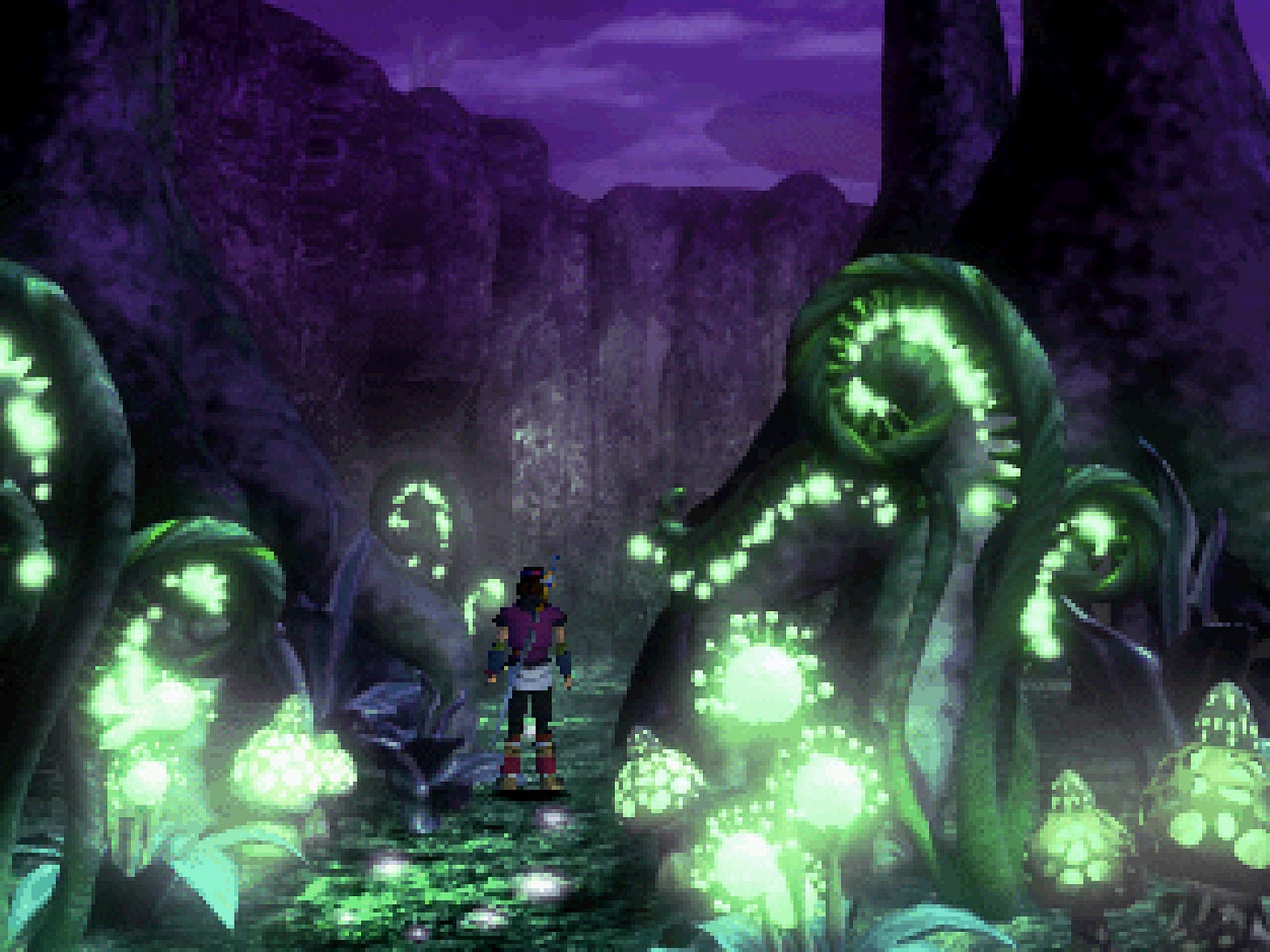
They have to be visited in a fixed order, and can’t be returned to after they’re complete (you also can’t visit any of the original forests once you reach the temple).
In each of those three dimensional forests, you battle elemental bosses, imaginatively named ‘Fire Boss’, ‘Air Boss’, and ‘Earth Boss'. Oddly, each only has a couple of lines of voiced dialogue when you find them, and none if you win, but if you *lose*, they say several more lines (all voiced) and have even more novel dialogue when you return to rebattle them (which I completely missed for the two I beat in my first try; good thing I unexpectedly ran into the other while wounded and unprepared).
Each elemental boss also ‘has a firm grip on the darkness in [the] heart’ of an important story character, and they… turn into that character to express some worries the character has been having, but that actually really is the character saying that… in a parallel dimension/Netherworld… or something? I don’t what’s going on there, story/lore-wise.
As soon as you defeat the Earth Boss, the crystals get combined, and the final boss appears, with no gap in between. When you win, a brief cutscene plays, and the credits roll.
So the strange structure looks something like this:
Intro cutscenes, setting the scene
Optional dialogue with town NPCs
Dungeon 1
New optional dialogue with town NPCs
Dungeon 2
New optional dialogue with town NPCs
Dungeon 3
New optional dialogue with town NPCs
Dungeon 3 again
Dungeon 4 (with no access to healing/merging/purification)
Point of no return after which you can no longer access the other forests
Dungeon 1 palette swap (not revisitable after)
Dungeon 2 palette swap (not revisitable after)
Dungeon 3 palette swap - ending in the final boss
I get the impression there was a lot more planned than was actually implemented (eg a water dungeon), and maybe they were really rushed towards the end just to finish. I suppose it’s better to actually finish though than to do what I do and get lost trying to make things perfect…
ALSO, the term ‘jade cocoon’ isn’t mentioned at all in the story! I suppose it’d hardly be the first anime style piece of media with a completely unrelated title, but it still bothers me! Especially since its full title seems to be “Jade Cocoon: Story of the Tamamayu”, but when I entered ‘tamamayu’ - another term that appears nowhere in the game - into Google translate, it came back as ‘jade cocoon’? So it’s called ‘Jade Cocoon: Story of the Jade Cocoon’, and it doesn’t feature any jade cocoons? Pfff!
I’m guessing more was intended for that specifically based on some bits of dialogue (including that by Ni up there). But I think they should have called the protagonist Jade Cocoon, like they do with the Final Fantasy games. Final Fantasy VII is my favourite. I like his spiky hair.
(I was going to make a joke about how I should do that with my own games, then realised I already did with MARDEK. Clarence’s middle and surname are Last Chance though. His full legal first name is Clarence’s.)
I find a lot of Jade Cocoon’s mechanical aspects really interesting; moreso than the average JRPG. Most notable is the game’s merging mechanic, where you can create creatures with their own unique appearances based on what you combine. This is probably why the game has stuck in my mind over the years!
For example, here are the minions I finished the game with:

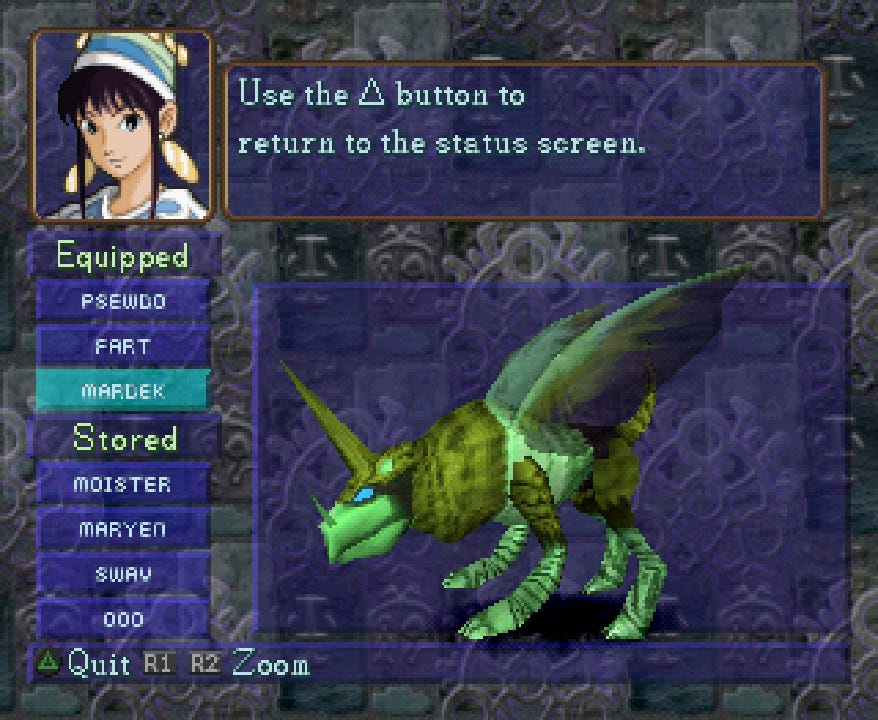
All of these are already the result of several mergings, and their (most recent) ancestors are viewable in a family tree like this:
I should mention at this point that while I played through the game on my phone, it was trivially easy to transfer the save files to my PC, where I can load them with the desktop version of the same emulator (RetroArch). So I’m able to take new screenshots as I write this. All things that I would never have even dreamed possible back when I first played this game as a child!
That means I can load my save and try to merge these monsters to see the result; thankfully you can preview it before committing.
Here’s PsEWdo + MArdEk:
It uses the posture (animation set) of the first minion and the texture of the second, but - most interestingly to me - it doesn’t simply reskin the model. It actually modifies the mesh itself, somehow; I still don’t understand exactly how. The textures change, too, in a way that seems to suggest more than a simple colour tint; I don’t understand that either.
Reversing the order gives me this:
Which is very different!
Here’s PsEWdo + FArt:
It’s still using the dragon posture and general form (and animations), but it’s much more upright than the other one.
And with the order reversed:
This kind of experimentation was absolutely fascinating to me as a child! It still is, even if I look at it through a more technical lens (trying to figure out how it works). I suppose the fact that it’s not obvious to me does help with immersion!
Here’s MArdEk + FArt. I think each minion might have the exact same parts with the same number of vertices or something, and they’re shifted between the positions of the two parents’ vertices? But it doesn’t seem to be that simple, since there’s quite a bit of variation between the creatures…
I haven’t seen anything remotely like this from any other games - Spore comes the closest, maybe? - but I suspect that it’s because it only really works due to the extremely low poly count of the models. I find it fascinating though that something so experimental was included in a finished game during the brief window when sufficiently simple models were state of the art.
There was a Jade Cocoon 2 on the PS2 (which I’ve played but never finished; I might try now I’ve replayed this), which does use more detailed models, and while it retains a merging mechanic, you just get one of the pre-made monsters rather than your own unique abomination.
I suppose maybe as a byproduct of the way these models work, the developers were easily able to add growth stages to every monster, which the convenient Wiki (there’s always a wiki) illustrates quite conveniently:
Essentially, every few levels, the minion increases in size, presumably by stretching out the positions of the vertices. While a huge fanfare is made when Pokemon evolve, I didn’t even realise this was happening in Jade Cocoon until I’d been playing the game for ages as a child, since it’s not described anywhere or announced in any way. I had to look up on the wiki to see what levels it even happens at.
In many ways, I’m reminded of this thing called Yden that I made in Flash years ago (this image is from 2014), in which human figures were generated from vector code. While I never had any intention to add growth stages to them, I was able to easily get the effect by just tweaking a few numbers; it took like an hour or something to add child and elderly versions of every person.
So effectively, every single monster in Jade Cocoon has five evolutionary stages, which means you get the benefits of keeping a form you like but also the pleasure of seeing it grow up from its training.
Every monster catcher game handles its monsters differently, and it’s done quite oddly here, again probably due to how trivially easy it was to add variations to the monsters.
Even though it’s a monster collector - and a big appeal of those is filling your collection - the Pokedex equivalent is just a screen that looks like this:
You can’t engage with it in any way to view information about any of the monsters. It’s also not clear when you encounter a new one whether you’ve captured that type before.
The wiki has a list of all the monsters in the game, which that list there suggests is 171, but I think there are only 32 unique ones. And even then, most are variations of types. For example Marrdreg, Raddreg, and Patdreg look like this (I appreciate whatever stranger put the effort into creating these turntable gifs for the wiki!):
They all share an animation set, but have different textures and seem to have some proportions shifted around. There are many like this, where there’s a ‘normal’ one, a ‘skinny’ one, and a ‘chunky’ one, all different species.
The game uses the four classical elements with a cyclical relationship: Fire beats Air beats Earth beats Water beats Fire. I think MARDEK’s elemental relationships were directly based on these from this game? Each minion has a single element, though merged minions have a combination of elements of different ratios based on their parents.
Each minion species also has variants for each of the elements… including the element of the ‘base’ minion. So for example, this is Hiralco, an Air elemental minion (in its fully grown form, which I’ve never actually seen in game despite using them often back in the day):
And here are its variants:
Hiralco and Skalco are both Air elemental and look almost identical, but count as different species.
While I like that there’s some consistency between names (eg the Pat- prefix means fire and is used for most fire variants, and all those use the -(a)lco suffix), a lot of the names are awkward, garbled, or unintentionally silly (eg Sgaj, Skwmoaj, Fugger). I definitely prefer Pokemon’s cleverly meaningful portmanteau names!
Most of the minions in the game are these variants, but most of them can’t even be accessed until a post-game area called the Eternal Corridor, which is as the name implies: a never-ending dungeon filled with randomly-selected minions, mostly these variants.

I remember spending a lot of time in the Eternal Corridor when I was little, hoping it’d lead to something… but it never did, and I see from the wiki that it never does, so I don’t think I’ll bother this time. Interesting development choice, though, as it does give essentially an all-you-can-eat amount of sort-of-procedurally-generated content if you just want to have mindless battles until you get bored. Means there’s no real conclusion though; it just fades out rather than ending on a strong note.
Also, the menu you can bring up looks like this:

Your character can participate in battles himself, and can equip a weapon and armour and everything; you have to switch to him to use any items or capture new minions. And you can only equip three minions, which do have their status displayed here… but you can’t actually view their models from the menu! You have to view them in the PC equivalent (where you can merge etc), or in battle. I wonder if that’s due to technical limitations, or if the devs didn’t even think players would want to view their unique minions from the menu??
I find the stat values interesting. The levels are low; I finished the game with my three minions around level 23. Each minion has the same five base stats as Pokemon, but they’re fairly small and don’t change much with each level; the wiki tells me the max value is 99. There’s a big difference between 40 and 42 Attack. HP rockets up as levels grow, though, so - unlike Pokemon, where eventually you just end up one-shotting most things - battles take about as long throughout the game; maybe even longer towards the end.
Each minion has a set of physical skills for certain body parts, and a list of spells. Here are MArdEk’s:
Each wild minion only has one or two of these, but the merged result retains all spells of its elements, and a combination of the body part skills based on both monsters. This means that merging is pretty much compulsory if you want versatile allies, which I quite liked.
What I didn’t like though is that most battles involve just spamming physical skills of whatever element the opponent is weak to. Magic always seemed to do less to the point of being mostly worthless. The elemental attack skills cost 10 Mana, though… unless they also have an enhancement, in which case they cost 20. MArdEk ended up with both its Earth and Air Attacks with +Accuracy, but since skills pretty much always hit anyway, that meant they cost double the Mana for essentially no benefit. And because managing Mana was a huge part of battles, it made using that minion far more awkward and difficult than it could have been. I wish there were a way to choose or get rid of the +Accuracy bonuses, but the only way to do that would be to override them with better bonuses (like the +Power that FArt has for both its Fire Attack and Air Attack), which is difficult because it’s hard to even find wild minions with those skills (I wasn’t able to at all), but even if I did, merging with them might create an ugly monstrosity with poor stats, since both appearance and stats are inherited too.
Also, you can only send out one minion at a time, but your opponent doesn’t have that restriction, and some wild battles would be against two or even three opponents at once, which was extremely unfair! Especially since there’s only one healing spell which only Water minions can use, Mana is quickly depleted by your skills, and it’s very difficult to grow much higher in level than a dungeon’s inhabitants so it’s not as if you ever have a huge advantage…
So it’s hardly a perfect system! But still, I found - and still do find - it a lot more interesting than a lot of generic RPG battle systems from the same era.
There were a couple of minions I remember from my childhood and wanted to use in my playthrough this time, but couldn’t because their skills and stats were crap!
Those things! Both are slow magic specialists, which is pretty much the opposite of what was optimal. Oh well!
This body type is similar to the Pokemon Hydreigon, though came years earlier. I liked this more aqua-coloured variation I almost merged!
And because I have the screenshots of them, here are some more monstrosities which are probably quite hard to visually parse from these low-resolution static screenshots:
I wonder if anyone read all that! I had fun writing it, regardless. I love this game a lot, and enjoyed revisiting it for the first time in I don’t know how long. Many memories came flooding back!
I don’t know that a game like this would - or even could - be produced these days, but I’m very glad that this one was made and that I got to experience it when I was young and impressionable!
Also, I liked that it didn’t overstay its welcome. I’m still in the middle of another - actually modern - game I started probably months ago at this point and still haven’t finished the story of, which I should return to now…

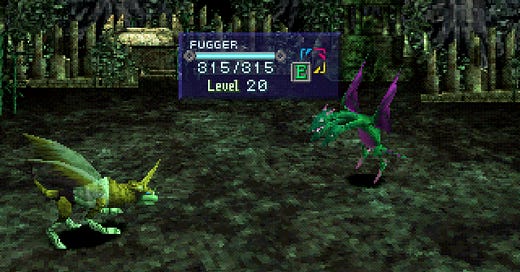


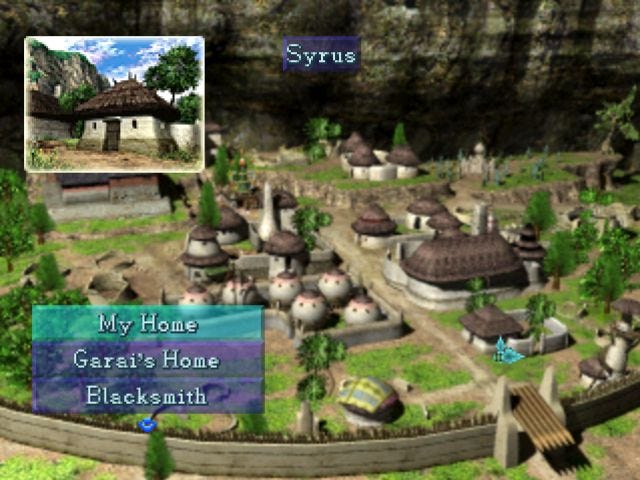


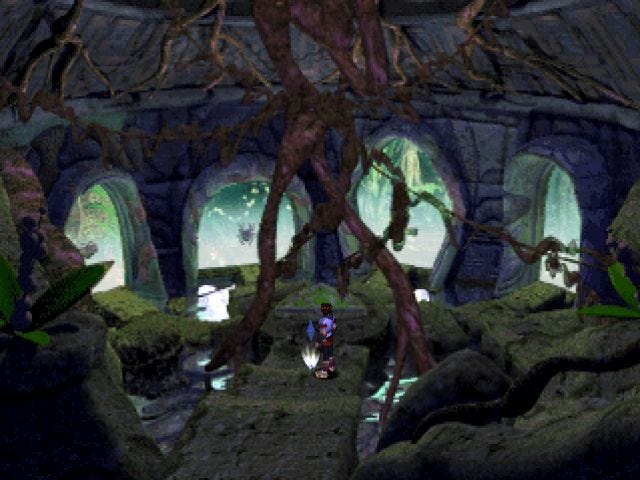
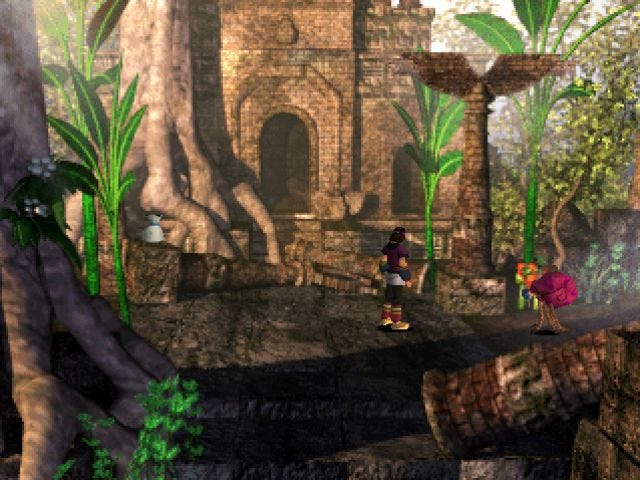

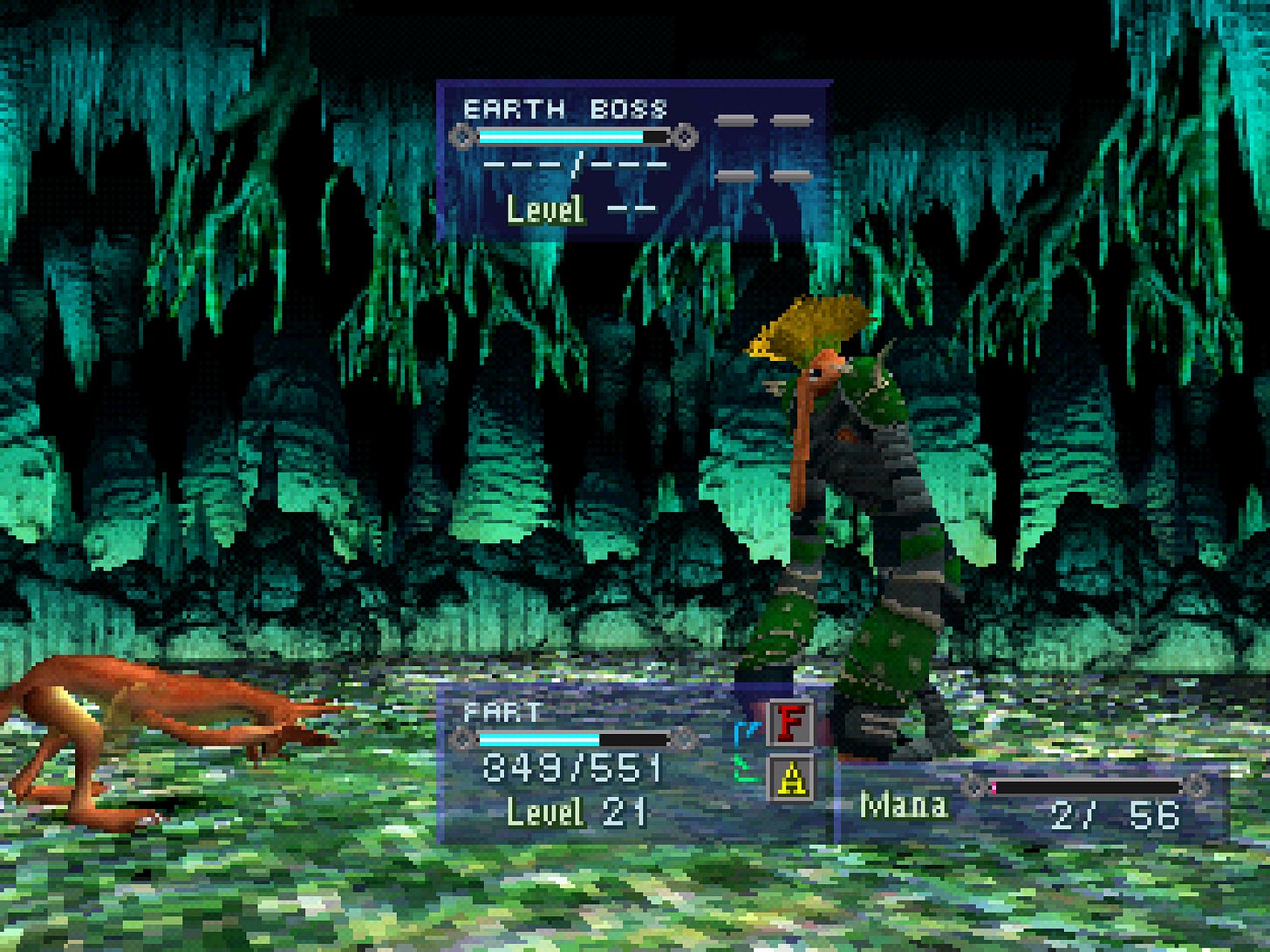




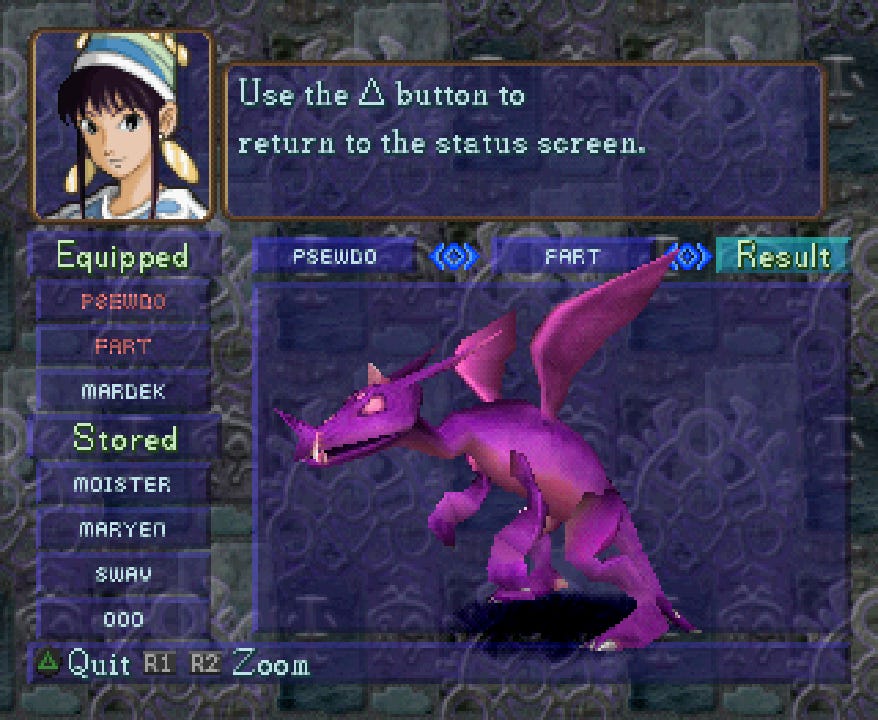



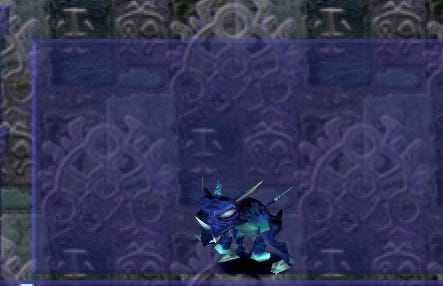

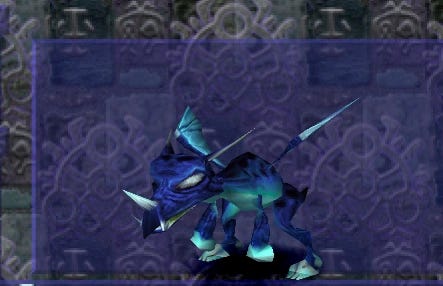
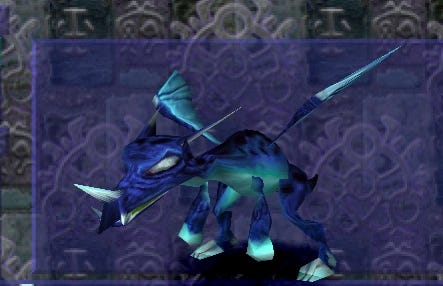
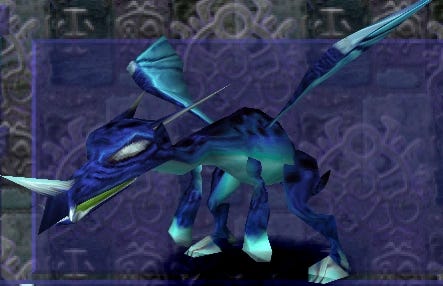
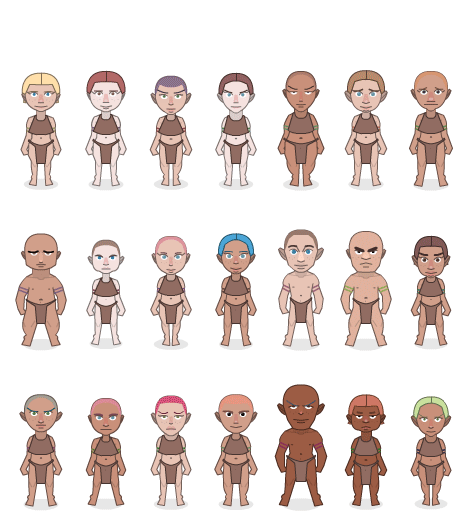

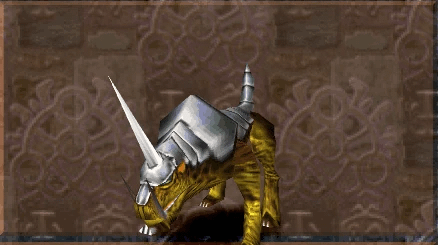
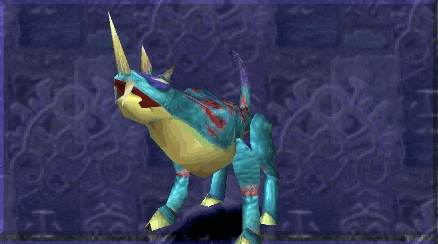
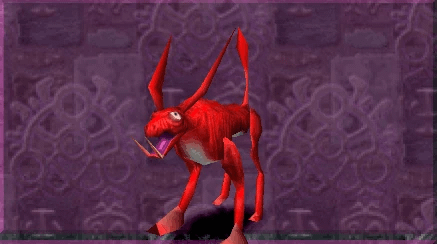
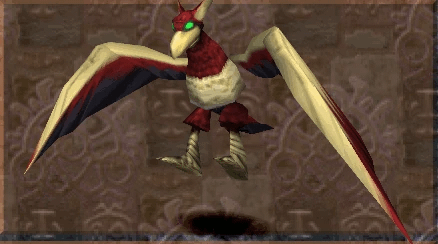
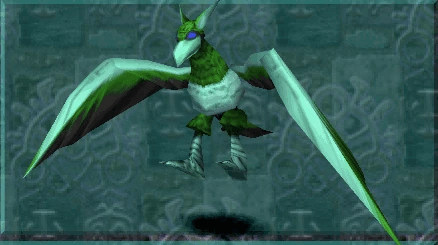
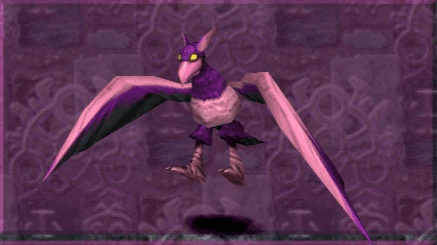
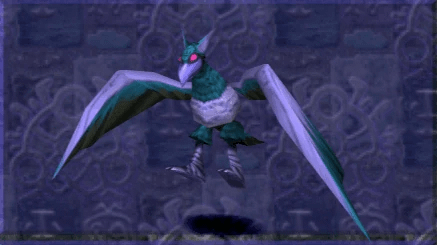

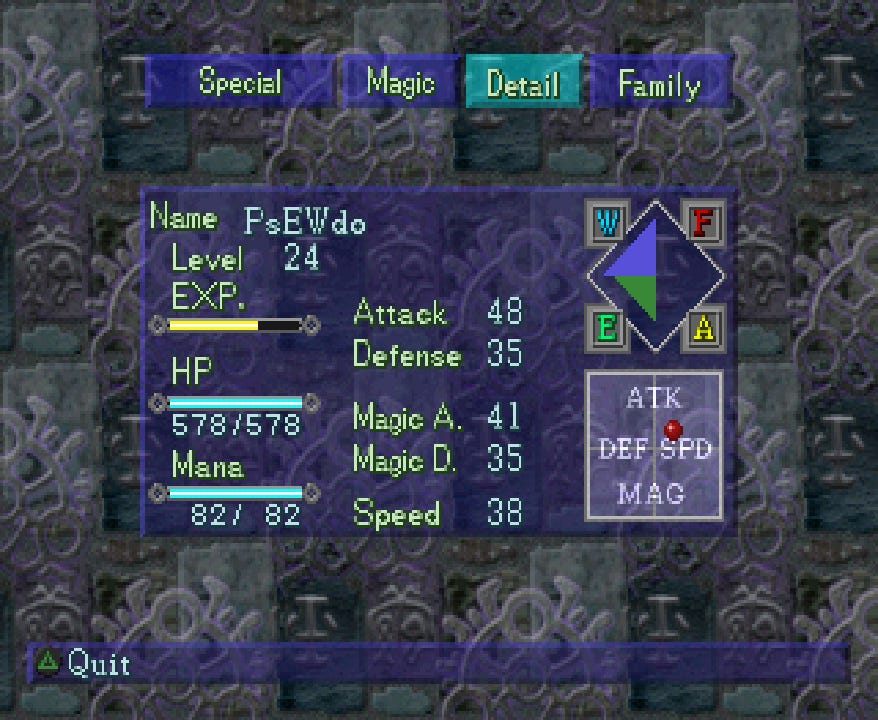













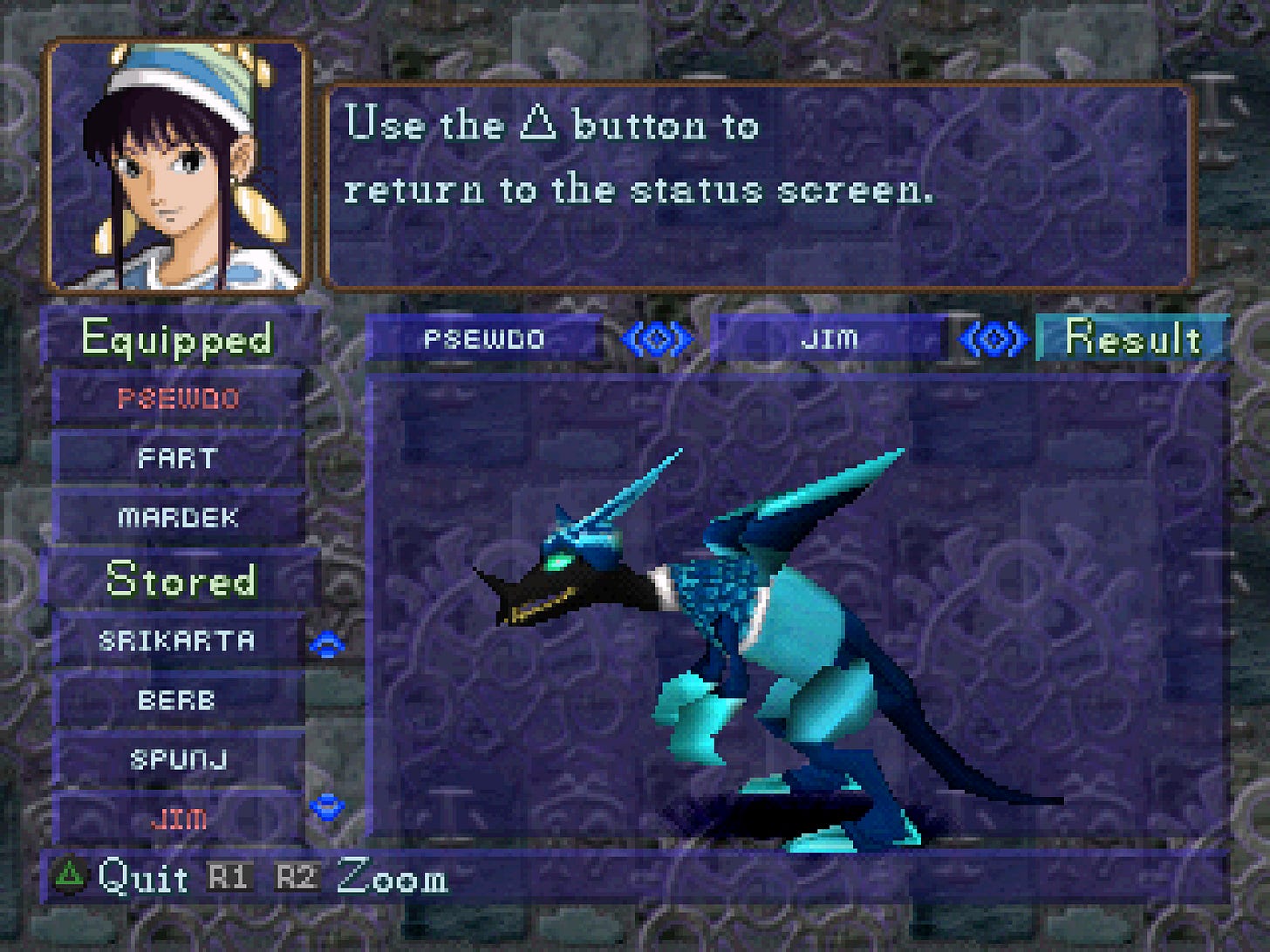

If you're interested in other monster catching games with spiritual themes the Megami Tensei franchise and its spinoffs are full of them. Was there anything about Jade Cocoon specifically that influenced your plans for Beast Signer?
My father gifted me this gem before my teenage years, it was no doubt a favorite in my mind, and always remained even though I've never finished it (I know of the second one but never got to play it)
I liked to take note of the elements the merging process was changing and slowly figuring out what kind of monsters increased which aspects of their body.
In the land of seemingly unknown but lovely games I'll always remember from the ps1 era, there was JadeCocoon, Tombi (1&2), Galerians (horror this one), Dino Crisis (1&2) and... I think it's called Alundra?
Ofc there are many more, but they stood out enough to be in my mind after so long.
As for the name Jade Cocoon I always thought it could refer to the whole "forest" aspect if the game, like a forest cocoon idea or something or to some trapping device made out of jade and nicknamed that way since we capture critters.
After a quick checking though, the name would actually mean "jade egg" and it does imply that the "pokeball" is made of jade in the process.